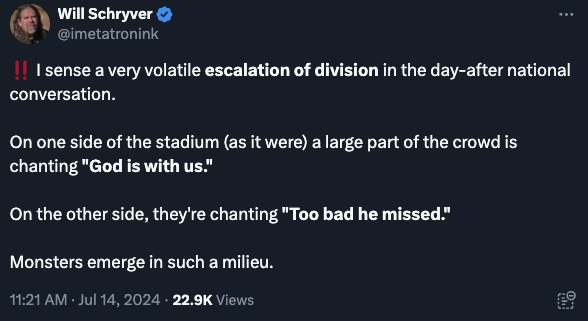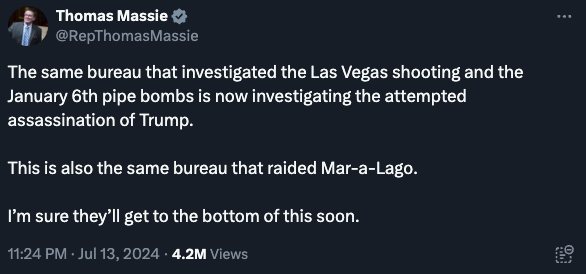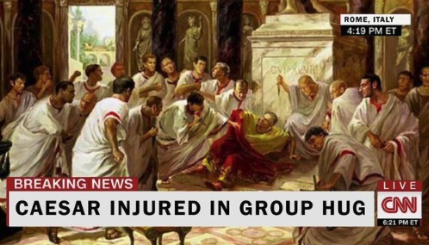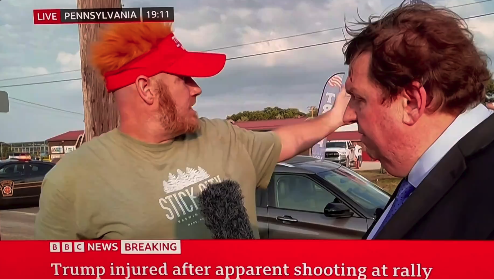The Madness Is Cranking Up
![]() When History Rhymes
When History Rhymes
 Just glancing at the calendar: Has it already been nearly eight weeks since the Trump assassination attempt?
Just glancing at the calendar: Has it already been nearly eight weeks since the Trump assassination attempt?
Your editor is old enough to have a vivid and unusual memory of the last time someone tried to kill a U.S. president.
It was March 30, 1981. In the Central time zone, it happened when the school day was almost over. At the conclusion of ninth-period English class, a student from a classroom nearby burst in: “Reagan got shot!”
I walked home and turned on CNN. At that time, CNN had been around for only a few months. It was an upstart outfit, willing to take chances the “Big 3” networks would not.
One chance it took that day was live and impromptu man-on-the-street interviews in New York.
Most people expressed the requisite shock and/or horror. Then there was a woman in her 30s who said something to the effect of, “Well, I guess I’m not surprised, really — what with the budget cuts he’s planning and all…”
The part about “He had it coming” was merely implied. Callous, perhaps, but harmless.
For whatever reason, the memory stuck. Somewhere in the early 2000s it occurred to me that the post-9/11 atmosphere in the country had turned so paranoid that had it happened then, the woman would have surely gotten a visit from the feds.
 With the passage of two more decades and another assassination attempt, well…
With the passage of two more decades and another assassination attempt, well…

A “volatile escalation of division”...
I penned some thoughts about all of this — including the market implications — only 48 hours after the attempt on Donald Trump’s life. Most of it has, I daresay, held up pretty well. Time for some updates and revisions in this holiday edition of our 5 Bullets.
For obvious reasons, I still can’t help thinking about a new American civil war — and a relevant episode from the old one.
In May 1863, Wall Street experienced a bull market known as the “Chancellorsville rise” — after a Confederate victory in Virginia that racked up more than 17,000 Union casualties. The market rallied on the theory that with the war lasting longer than expected, the Union government would have to issue more inflationary “greenbacks.”
Easy money fueling a bull market. Sound familiar?
![]() “The Trump Trade”
“The Trump Trade”
 In the immediate aftermath of the attempt to take out Trump, Mr. Market was pricing in a Trump victory come November. Bloomberg called it “the Trump trade.”
In the immediate aftermath of the attempt to take out Trump, Mr. Market was pricing in a Trump victory come November. Bloomberg called it “the Trump trade.”
“The series of wagers — based on anticipation that the Republicans’ return to the White House would usher in tax cuts, higher tariffs and looser regulations — had already been gaining ground since President Joe Biden’s poor performance in last month’s debate imperiled his re-election campaign.”
That was then, this is now: “The topsy-turvy U.S. presidential election has Wall Street racing to adjust its bets,” Bloomberg reported last week, “as Democratic party candidate Vice President Kamala Harris keeps surging in the polls against the once presumptive favorite, Republican former president Donald Trump…
“Indexes from Goldman Sachs Group Inc. that track trading strategies for each party show the Democratic one started outperforming the Republican one right around the time Biden stepped down as candidate.”
For once, Wall Street and corporate media have it right: “The election is far from over and far from certain,” Paradigm’s Jim Rickards wrote his Situation Report readers last week. And this is after Jim confidently forecast a Trump victory over Biden throughout the first half of 2024.
Adding to the volatile atmosphere: In the immediate aftermath of the assassination attempt, billionaires Elon Musk and Bill Ackman endorsed Trump.
Neither was exactly a surprise — but the news reinforced the impression that competing cadres of billionaires are lining up on opposite sides in this election.
That’s a stark change from eight years ago — and another “volatile escalation of division” suggesting incipient civil war. Read on…
![]() Disturbing Discourse (NOT the “Bull’s-Eye”)
Disturbing Discourse (NOT the “Bull’s-Eye”)
 Already there’s a disturbing turn in the discourse across these United States — as if 2024 wasn’t already a terrible year for freedom of expression.
Already there’s a disturbing turn in the discourse across these United States — as if 2024 wasn’t already a terrible year for freedom of expression.
You didn’t have to look far on social media to find howls from the right about how Joe Biden and/or other Democrats “incited” the attempt on Trump’s life.
Really? Biden said, “We’re done talking about the debate, it’s time to put Trump in a bull’s-eye” — and that’s some sort of dog whistle to activate a sleeper or something?
Isn’t this hand-wringing the kind of “words are violence” rhetoric that’s come from the left for many years? Justifying all manner of social-media censorship in the name of policing “hate speech”?
Yeah, it cuts both ways. On X-formerly-Twitter, the irascible political reporter Michael Tracey reminds us of an episode in which liberals accused conservatives of incitement: Sarah Palin’s political action committee used bull’s-eye imagery to denote the congressional districts the PAC was “targeting” in the 2010 midterms — including that of Rep. Gabrielle Giffords (D-Arizona), who was shot and wounded in early 2011.

It’s a metaphor, people. Gee, whatever happened to the conservative defense that Trump’s words should be taken “seriously but not literally”?
 That said, the critics on the right have one valid point.
That said, the critics on the right have one valid point.
You don’t get to spend eight-plus years demonizing Trump as “literal Hitler,” a threat to “our democracy,” an agent of a foreign power — and then act surprised when someone tries to put a bullet in him. Nor do you get to wish him a speedy recovery and say political violence is never acceptable. (Remember that?)
I for one would like to hear from neoconservative theorist Robert Kagan, who published a 6,000-word screed in The Washington Post last November practically begging for Trump’s assassination.
Don’t take my word for it — decide for yourself. Here’s a non-paywalled link. As the independent journalist Matt Taibbi said, “It could have been headlined, ‘Where’s Hinckley When You Need Him?’”
And yet… despicable as Kagan’s rhetoric may be, it is and should be protected speech.
More than 50 years ago, the Supreme Court drew bright red lines about what constitutes incitement. Sensible lines they are: Unless, for instance, you’re standing outside someone’s house with a mob urging them to burn it down at that moment, everything is fair game. Only “imminent lawless action” is off-limits.
I sure as hell don’t want to live in a world where the woman in New York on the day of the Reagan shooting would feel as if she had to police her thoughts lest they be viewed by overwrought politicos as “incitement to violence.”
![]() Trust in “the System”? Forget It…
Trust in “the System”? Forget It…
 Meanwhile, the erosion of trust in “the system” that began with the JFK assassination is probably beyond the breaking point. Justly so…
Meanwhile, the erosion of trust in “the system” that began with the JFK assassination is probably beyond the breaking point. Justly so…

It’s worth recalling here that the resignation of Secret Service chief Kimberly Cheatle is an exceedingly rare instance of a senior government official falling on her sword. Even so, it didn’t happen until 10 days after the shooting.
Before she stepped down, the journalist Jeff Stein — who’s been covering the Washington scene since the 1970s — wrote in his SpyTalk column on Substack…
In my adult lifetime, I can’t recall a senior official taking responsibility for the millions of lives lost from their failures — or outright mendacity — ranging from Vietnam, through Cuba, Chile and Central America, onward through 9/11, through Iraq and Afghanistan, not to mention domestic disasters like opioid megadeaths and bank collapses, and done the right thing by stepping up, apologizing and resigning out of principle. My AI searches for examples came up blank.
Here at 5 Bullets, our memories are nearly as empty: The only instance before Cheatle we can recall was FEMA director Michael Brown after Hurricane Katrina in 2005. That’s how little accountability there is within the Beltway.
Mr. Stein also reminds us that some of the Secret Service agents on JFK’s detail were so drunk after a night of carousing in Dallas they could hardly walk.
Writes Jefferson Morley, a journalist who’s been suing the CIA for over 20 years to open up all the JFK records…
The cultural reflexes engrained by the trauma of Nov. 22 and the ensuing governmental coverup have been unleashed by the near-miss of July 13: deep suspicion of the authorities, distrust of democratic institutions, fear of a high-level plot and the sense of things falling apart, all turbocharged by a social media information system unknown in the 1960s and 1970s.
![]() The Media… and the Process of “Othering”
The Media… and the Process of “Othering”
 I suppose I should say a thing or two about the corporate media, seeing as that’s how I earned my living for the first 20 years of my adulthood.
I suppose I should say a thing or two about the corporate media, seeing as that’s how I earned my living for the first 20 years of my adulthood.
For all the roasting the media got for its initial hesitancy to label what happened the evening of July 13 as an assassination attempt…

… there were several instances in which the legacy media acquitted itself with professionalism.
It was a New York Times photographer who got the justly famous bullet photo. It was the New York Post that named the suspect two hours before the officials did. It was Pittsburgh’s CBS outlet that scored early interviews with the suspect’s classmates. And Pittsburgh’s NBC affiliate uncovered damning failures on the part of the people charged with Trump’s protection.
Most important, it was BBC reporter Gary O’Donoghue who got the interview with the red-haired guy who said he saw the gunman climbing up a building to the roof, rifle in hand — and who tried to warn the authorities to no avail.

The process that ended with Cheatle’s resignation began with Greg Smith’s account going viral barely an hour after the shots rang out. Millions of people saw it, and they can’t unsee it.
Near as we can tell, Smith has kept his silence since that night. Presumably the feds have interviewed him extensively by now. Given how millions of people already know his story, it would have been mighty hard for the feds to browbeat him into changing that story.
In other words, they weren’t able to do to him what they did to the several witnesses who saw a mysterious woman in a polkadot dress the night that Robert F. Kennedy was killed in 1968.
 It was tempting, 48 hours after the shooting, to think that “the drama is all over now.”
It was tempting, 48 hours after the shooting, to think that “the drama is all over now.”
Even before the shooting, Trump was starting to look competitive in “blue” states like Virginia and Minnesota.
But going into Labor Day weekend, Harris might have a shot at battleground states like Georgia that were previously leaning Trump.
It’s still 64 days until Election Day. And 140 days until the inauguration.
The “volatile escalation of division” is not over. The process of “othering” has not been arrested — a process described by historian Michael Vlahos in The American Conservative in 2018: “Warring identities have concluded that the only solution is the complete submission of the enemy party, and both sides are beginning to prepare for an ultimate showdown.
“Othering is a transforming process, through which former kin are reimagined as evil, an American inner-enemy, who once defeated must be punished.”
Vlahos even likened the red-blue divide to “an irreparable religious schism, deeper in doctrinal terms even than the 16th-century Catholic-Protestant schism.”
With that in mind, we cited the aforementioned Matt Taibbi back in July — with a cautionary note that does not let corporate media off the hook.
“We should probably all steel ourselves for what will surely be the Mother of All Propaganda Onslaughts. To say this is a critical moment in American history is an understatement.
“Everything is on the line, which means no lie will be out of bounds, no move too treacherous to try. Madness incarnate, and nowhere near over.”
Indeed, the madness is sure to be cranked up even further here in September.
We close with the words of Dubya Bush’s White House chief of staff Andrew Card in 2002 — foreshadowing the Bush/Cheney propaganda onslaught before the invasion of Iraq in 2003.
“From a marketing point of view, you don’t introduce new products in August.”










